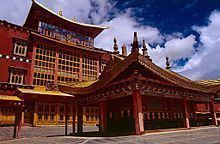Time zone China Standard (UTC+8) Website www.shangri-la.gov.cn Area 11,613 km² Area code 0887 | Postal code 674400 Elevation 3,160 m Province Yunnan | |
 | ||
Country People's Republic of China Prefecture Diqing Tibetan Autonomous Prefecture Points of interest Tiger Leaping Gorge, Potatso National Park, Haba Xueshan, White Water, Guishan Park | ||
Shangri-La is a county-level city in northwestern Yunnan province, People's Republic of China and is the location of the seat of the Dêqên Tibetan Autonomous Prefecture.
Contents
- Map of Shangri La Deqen Yunnan China
- Shangri la city yunnan china
- Name
- Towns
- Climate
- National park
- Transport
- References
Map of Shangri-La, Deqen, Yunnan, China
Shangri la city yunnan china
Name
In the second half of the 20th century Shangri-La was called Zhongdian (Chinese: 中甸 Zhōngdiàn) but was renamed on 17 December 2001 as Shangri-La (other spellings: Semkyi'nyida, Xianggelila, or Xamgyi'nyilha) after the fictional land of Shangri-La in the 1933 James Hilton novel Lost Horizon, in an effort to promote tourism in the area. The original Tibetan population previously referred to this place by its traditional name Gyalthang or Gyaitang (Standard Tibetan: རྒྱལ་ཐང།; Wylie: rgyal thang, ZWPY: Gyaitang), meaning "Royal plains". This ancient name is reflected in the Tibetan Pinyin name of the town of Jiantang (建塘; Jiàntáng), the county seat.
Towns
In the early morning of January 11, 2014, a fire broke out in the 1,000-year-old Dukezong Tibetan neighborhood. About 242 homes and shops were destroyed and 2,600 residents were displaced. About half of the old town was destroyed by the fire, half was spared. After the fire residents were allowed back to their homes and shops. By the end of 2014 rebuilding had started and tourism started to come back. Generally tourism was not affected by the fire, since the main sights in the old town, such as the prayer wheel and temples were not damaged. Many of the other main sights are located outside of the old town.
Climate
Shangri-La has a monsoon-influenced humid continental climate (Köppen Dwb), due to the high elevation. Winters are chilly but sunny, with a January 24-hour average temperature of −3.2 °C (26.2 °F), while summers are cool, with a July 24-hour average temperature of 13.5 °C (56.3 °F), and feature frequent rain; more than 70% of the annual precipitation is delivered from June to September. The annual mean is 5.85 °C (42.5 °F). Except during the summer, nights are usually sharply cooler than the days. Despite the dryness of the winter, the small amount of precipitation is generally sufficient to cause major transportation dislocations and isolate the area between November and March. Being located just 27° in latitude from the equator, the effects of altitude on the climate are so exceptional that it actually means the average yearly temperature is 2.5°C lower than that for Bergen, Norway, located as much as 60° from the equator.
